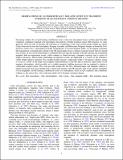| dc.contributor.author | Orange, N. Brice | |
| dc.contributor.author | Chesny, David L. | |
| dc.contributor.author | Oluseyi, Hakeem | |
| dc.date.accessioned | 2015-11-24T18:53:40Z | |
| dc.date.available | 2015-11-24T18:53:40Z | |
| dc.date.issued | 2015-09 | |
| dc.date.submitted | 2015-01 | |
| dc.identifier.issn | 1538-4357 | |
| dc.identifier.issn | 0004-637X | |
| dc.identifier.uri | http://hdl.handle.net/1721.1/100037 | |
| dc.description.abstract | Increasing evidence for coronal heating contributions from cooler solar atmospheric layers, notably quiet Sun (QS) conditions, challenges standard solar atmospheric descriptions of bright transition region (TR) emission. As such, questions about the role of dynamic QS transients in contributing to the total coronal energy budget are raised. Using observations from the Atmospheric Imaging Assembly and Heliosemic Magnetic Imager on board the Solar Dynamics Observatory, and numerical model extrapolations of coronal magnetic fields, we investigate a dynamic QS transient that is energetically isolated to the TR and extrudes from a common footpoint shared with two heated loop arcades. A non-causal relationship is established between episodic heating of the QS transient and widespread magnetic field re-organization events, while evidence is found favoring a magnetic topology that is typical of eruptive processes. Quasi-steady interchange reconnection events are implicated as a source of the transient's visibly bright radiative signature. We consider the QS transient's temporally stable (≈35 minutes) radiative nature to occur as a result of the large-scale magnetic field geometries of the QS and/or relatively quiet nature of the magnetic photosphere, which possibly act to inhibit energetic build-up processes that are required to initiate a catastrophic eruption phase. This work provides insight into the QS's thermodynamic and magnetic relation to eruptive processes that quasi-steadily heat a small-scale dynamic and TR transient. This work explores arguments of non-negligible coronal heating contributions from cool atmospheric layers in QS conditions and contributes evidence to the notion that solar wind mass feeds off of dynamic transients therein. | en_US |
| dc.description.sponsorship | United States. National Aeronautics and Space Administration (Grant NNX-07AT01G) | en_US |
| dc.description.sponsorship | National Science Foundation (U.S.) (Grant AST-0736479) | en_US |
| dc.language.iso | en_US | |
| dc.publisher | IOP Publishing | en_US |
| dc.relation.isversionof | http://dx.doi.org/10.1088/0004-637x/810/2/98 | en_US |
| dc.rights | Article is made available in accordance with the publisher's policy and may be subject to US copyright law. Please refer to the publisher's site for terms of use. | en_US |
| dc.source | IOP Publishing | en_US |
| dc.title | OBSERVATIONS OF AN ENERGETICALLY ISOLATED QUIET SUN TRANSIENT: EVIDENCE OF QUASI-STEADY CORONAL HEATING | en_US |
| dc.type | Article | en_US |
| dc.identifier.citation | Orange, N. Brice, David L. Chesny, and Hakeem M. Oluseyi. “OBSERVATIONS OF AN ENERGETICALLY ISOLATED QUIET SUN TRANSIENT: EVIDENCE OF QUASI-STEADY CORONAL HEATING.” The Astrophysical Journal 810, no. 2 (September 3, 2015): 98. © 2015 The American Astronomical Society | en_US |
| dc.contributor.department | Massachusetts Institute of Technology. Department of Physics | en_US |
| dc.contributor.mitauthor | Oluseyi, Hakeem | en_US |
| dc.relation.journal | The Astrophysical Journal | en_US |
| dc.eprint.version | Final published version | en_US |
| dc.type.uri | http://purl.org/eprint/type/JournalArticle | en_US |
| eprint.status | http://purl.org/eprint/status/PeerReviewed | en_US |
| dspace.orderedauthors | Orange, N. Brice; Chesny, David L.; Oluseyi, Hakeem M. | en_US |
| mit.license | PUBLISHER_POLICY | en_US |
| mit.metadata.status | Complete | |
